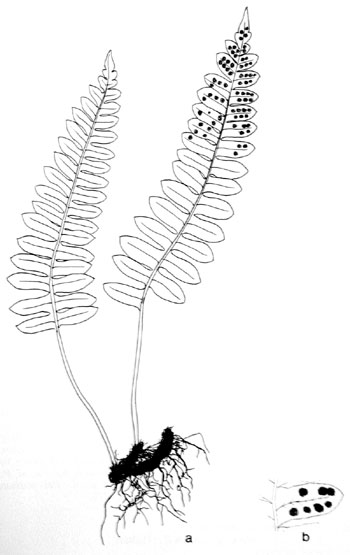|
Hardy Fern Home P. hesperium resources
All Ferns � Polypodiaceae �� Polypodium
�Other Genera
|
| Polypodium hesperium | ||
Western polypody, walking fern | ||
|
Etymology
From the Greek, hesperus, meaning of the West.
Description
Rhizome: creeping, branching, slender, whitish waxy sometimes, about 5 mm diameter, acrid to sweet flavored, scales lanceolate, brown or slightly mottled, often darker near point of attachment.
Frond: 25 cm high by 7 cm wide, evergreen, monomorphic, blade/stipe ratio: 2:1. Stipe: jointed at base, straw-colored, glabrous or scattered with thin light-brown scales, vascular bundles: 3. Blade: pinnatifid, oblong, usually widest near middle, occasionally at or near base, herbaceous, ligt to yellowish-green, glabrous above, sometimes a few scales below. Pinnae: 8 to 12 pair, oblong, less than 3 cm long, tips obtuse to acute; margins entire to crenulate; veins free, hard to see. Sori: oval when immature, round later, less than 3 mm diam., midway between margin and midrib to nearly marginal; on all but the lowest pinnae of fertile fronds, indusium: absent, sporangia: yellow to dark brown or reddish black at maturity; paraphyses absent, maturity: summer to fall. Culture
Habitat: cracks and ledges on cliffs, on a variety of noncalcareous substrates.
Distribution: western North America: British Columbia to northern Mexico, at higher altitudes.
Hardy to -30�C, USDA Zone 4.
Distinctive Characteristics
A combination of characters is required to be sure of P. hesperium: small, herbaceous, non-leathery fronds, marginal or medial sori under 3 mm, no paraphyses.
Synonyms
Polypodium prolongilobum Clute Polypodium vulgare Linnaeus subsp. columbianum (Gilbert) Hult�n Polypodium vulgare var. columbianum Gilbert Polypodium vulgare var. hesperium (Maxon) A. Nelson & J. F. Macbride Compare with other species in the Western North America Group
|
|
|
Notes
Parents P. glycyrrhiza and P. amorphum. This is intermediate in size, the former being quite the larger plant, the latter quite the smaller. Differs also from P. glycyrrhiza in the lack of hairs on the upper side of the rachis.
Parents P. glycyrrhiza and P. amorphum. This is intermediate in size, the former being quite the larger plant, the latter quite the smaller. Differs also from P. glycyrrhiza in the lack of hairs on the upper side of the rachis.

Polypodium hesperium. Habit and habitat, Clearwater National Forest, Idaho. �USDA Forest Service |
